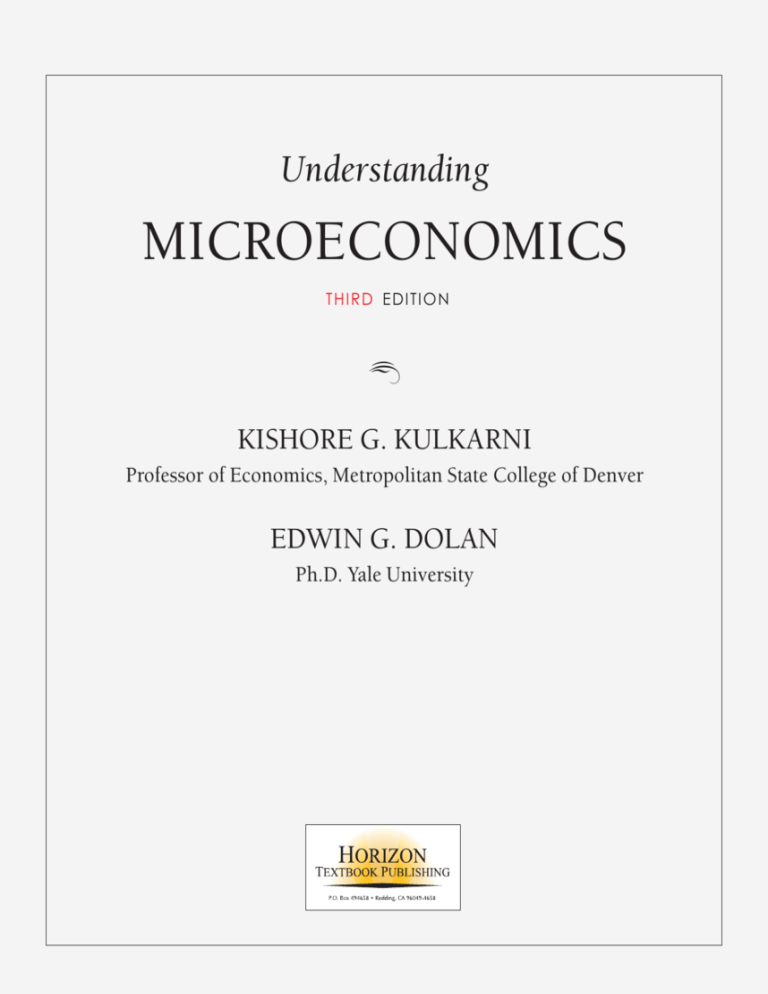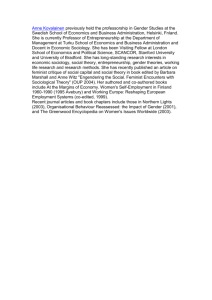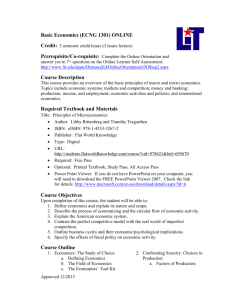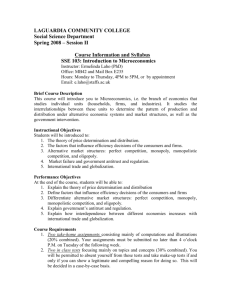
Understanding
MICROECONOMICS
THIRD EDITION
d
KISHORE G. KULKARNI
Professor of Economics, Metropolitan State College of Denver
EDWIN G. DOLAN
Ph.D. Yale University
E DITOR : Kristin Van Gaasbeck
T EXT D ESIGN
AND
C OMPOSITION : Archetype Book Composition
C OVER D ESIGN : Walker Printing
ISBN: 1-60229-242-6
Copyright © 2007 by Horizon Textbook Publishing, LLC
All rights reserved. Printed in the United States of America. No part of this book may be used or reproduced in any manner whatsoever without written permission, except in the case of brief quotations
embodied in critical articles and reviews. For information address Horizon Textbook Publishing, LLC,
P.O. Box 494658, Redding, CA 96049-4658.
TABLE OF CONTENTS
d
Preface
xiii
PART 1 Introduction to Economics
CHAPTER 1 ECONOMICS—THE SCIENCE OF CHOICE AND
EXCHANGE
What? How? For Whom?
Deciding What to Produce: Opportunity Cost
Deciding How to Produce: Efficiency and Entrepreneurship
Deciding Who Will Do Which Work: The Division of Labor
Deciding for Whom Goods will be Produced: Positive and Normative
Economics
Coordinating Economic Choices
A Non-economic Example
Spontaneous Order in Markets
The Role of Hierarchy
Economic Method
Theories and Models
The Use of Graphs4
Theory and Evidence
Theories and Forecasts
Theory and Policy
Summary
Key Terms
Problems and Topics for Discussion
Case for Discussion
3
5
5
6
10
12
14
15
15
17
17
18
19
21
21
23
24
25
25
26
iii
iv
Contents
End Notes
Appendix to Chapter 1: Working with Graphs
CHAPTER 2 SUPPLY AND DEMAND: THE BASICS
Law of Demand
The Demand Curve
Shifts in the Demand Curve1
THE LAW OF Supply
The Supply Curve
Shifts in the Supply Curve
The Interaction of Market Supply and Demand: Market Mechanism
Market Equilibrium
Equilibrium as Spontaneous Order
Shortages
Surpluses
Changes in Market Conditions: Outside Shocks to Market Mechanism)
Price Floors and Ceilings: An Application
Price Supports: The Market for Milk
Price Ceilings: The Case of Rent Control
Summary
Key Terms
Problems and Topics for Discussion
Case for Discussion
End Notes
CHAPTER 3 SUPPLY, DEMAND, AND ELASTICITY
Elasticity Of Demand
Price Elasticity of Demand
Calculating Elasticity of Demand
Varying- and Constant-Elasticity Demand Curves
Determinants of Elasticity of Demand
Income Elasticity of Demand
Cross-Elasticity of Demand
Price Elasticity of Supply
Applications of Elasticity
Elasticity and Tax Incidence
Elasticity and Prohibition
Summary
Key Terms
Problems and Topics for Discussion
27
29
39
40
41
42
47
47
50
52
53
53
55
56
56
60
60
62
67
68
68
69
70
71
72
72
74
77
78
80
81
81
83
83
87
90
91
91
Contents
Case for Discussion
End Notes
92
93
PART 2 The Basic Theory of Prices and Markets
CHAPTER 4 ECONOMIC THEORY, MARKETS, AND GOVERNMENT 97
Will Coal Be King Again?
The Structure of Economic Theory
Objectives, Constraints, and Choices
Economic Theory and Rationality
Full and Bounded Rationality
Market Performance and Market Failure
Market Performance
Market Failure
The Economic Role of Government
The Market Failure Theory of Government
The Public Choice Theory of Government
Looking Ahead
Summary
Key Terms
Problems and Topics for Discussion
Case for Discussion
A Price That’s Too Good to Be Bad
End Notes
CHAPTER 5 CHOICES BY CONSUMERS
Utility and the Rational Consumer
Utility
Constraints on Opportunities
Diminishing Marginal Utility and Consumer Choice
From Consumer Equilibrium to the Law of Demand
Substitution and Income Effects
The Substitution Effect
The Income Effect
Income and Substitution Effects and the Demand Curve
Applications of Income and Substitution Effects
The Demand for Safety
Children as Durable Consumer Goods
Consumer Surplus
The Demand Curve as Willingness to Pay
97
99
99
100
103
104
104
106
111
111
112
114
115
116
116
117
117
118
119
120
120
120
121
123
124
124
124
125
126
128
128
129
130
v
vi
Contents
Measuring the Surplus
Consumer Surplus, Producer Surplus, and Gains from Exchange
Application: The Excess Burden of a Tax
Summary
Key Terms
Problems and Topics for Discussion
Case for Discussion
End Notes
Appendix to Chapter 5: Indifference Curves
CHAPTER 6 ECONOMICS AND ENVIRONMENTAL POLICY
Pollution Abatement as a Problem of Scarcity
The Benefits of Waste Discharge and the Costs of Pollution Abatement
The Marginal External Cost of Pollution
The Optimal Quantity of Pollution
Criticisms of the Optimal-Pollution Concept
Controlling Externalities Through Voluntary Exchange
Markets Without Transaction Costs
Market Resolution of Externalities in Practice
Transaction Costs as Barriers to Voluntary Resolution of Externalities
Controlling Externalities through regulation
Command and Control
Emission Charges
Cap-and-Trade
Environmental Policy and Public Choice
Environmental Policy in a Democracy
Vote Trading and Special Interests
Global Aspects of Pollution Control
Summary
Key Terms
Problems and Topics for Discussion
Case for Discussion
End Notes
CHAPTER 7 GLOBAL TRADE AND TRADE POLICY
The Theory of Comparative Advantage: Review and Extensions
Numerical Approach
Graphical Presentation
The World Production Possibility Frontier
130
131
133
134
135
135
136
137
139
147
148
148
150
150
150
152
153
154
156
157
157
158
160
161
162
162
165
168
168
169
169
171
173
175
175
177
179
Contents
Effects of Trade
Empirical Evidence on Comparative Advantage
Comparative Advantage with Multiple Factors of Production
The Importance of Demand
Comparative Advantage and “Competitiveness”
Trade Policy and Protectionism
Moves Toward Freer Trade Since World War II
Countertrends: The New Protectionism
Understanding Protectionism: Impacts of Trade on Income Distribution
Protectionism and Public Choice
A Race to the Bottom?
Summary
Key Terms
Problems and Topics for Discussion
Case for Discussion
End Notes
179
180
180
181
181
184
184
186
188
189
190
192
193
193
193
194
PART 3 Economics of the Firm
CHAPTER 8 PRODUCTION AND COST
Costs and Profits
The Profit Motive
The Nature of Costs
Profit, Rents, and Entrepreneurship
Fixed Costs, Variable Costs, and Sunk Costs
Production and Costs in the Short Run
Production with One Variable Input in the Short Run
From Marginal Physical Product to Marginal Costs
More Than One Variable Input
A Set of Short-Run Cost Curves
Some Geometric Relationships
Long-Run Costs and Economies of Scale
Planning for Expansion
Economies of Scale
Summary
Key Terms
Problems and Topics for Discussion
Case for Discussion
End Notes
Appendix to Chapter 8: Cost and Output with Two Variable Inputs
197
197
198
199
202
203
205
206
209
209
211
211
214
215
217
220
221
221
222
223
225
vii
viii
Contents
CHAPTER 9 DEMAND AND SUPPLY UNDER PERFECT
COMPETITION
Perfect Competition and Supply in the Short Run
The Constraints
Short-Run Profit Maximization for the Firm
Minimizing Short-Run Losses
Shutting Down to Cut Short-Run Losses
The Firm’s Short-Run Supply Curve
The Industry’s Short-Run Supply Curve
Long-Run Equilibrium Under Perfect Competition
Long-Run Equilibrium for a Competitive Firm
Industry Adjustment to Falling Demand
Industry Adjustment to Rising Demand
The Elasticity of Long-Run Supply
Market Performance Under Perfect Competition
What Should be Produced
How to Produce
Other Aspects of Market Performance
Summary
Key Terms
Problems and Topics for Discussion
Case for Discussion
End Notes
CHAPTER 10 THE THEORY OF MONOPOLY MARKET
Varieties of Monopoly
Simple Monopoly
Constraints Faced by Monopoly
Output, Price, and Marginal Revenue Under Simple Monopoly
Finding the Point of Maximum Profit
Profit Maximization or Loss Minimization?
Profit Maximization in the Long Run
Long-Run Equilibrium Without Threat of Entry
Open Monopoly, Entrepreneurship, and Limit Pricing
Closed Monopoly and Rent Seeking
Complex Pricing Strategies
Price Discrimination
Fairness and Price Discrimination
Two-Part Pricing
231
233
233
235
238
241
242
243
244
245
246
248
250
252
252
253
254
255
256
256
257
258
259
260
261
261
262
264
266
268
269
269
271
273
273
274
275
Contents
Market Performance Under Monopoly
What to Produce: Consumer and Producer Surplus
How to Produce: Average Total Cost in Monopoly Equilibrium
For Whom Does Monopoly Promote Inequality?
A Balance Sheet
Summary
Key Terms
Problems and Topics for Discussion
Case for Discussion
CHAPTER 11 MARKETS OF MONOPOLISTIC COMPETITION
AND OLIGOPOLY
Market Structure in the U.S. Economy
Aggregate Concentration
Measures of Market Concentration
Blending Structural and Behavioral Evidence
Causes of Market Concentration
Theory of Oligopoly: Interdependence and Collusion
The Constraint of Oligopolistic Interdependence
Cartels
Coordination Without Collusion
Market Performance Under Oligopoly
The Theory of Monopolistic Competition
Profit Maximization Under Monopolistic Competition
The Performance of Monopolistically Competitive Industries
Summary
Key Terms
Problems and Topics for Discussion
Case for Discussion
End Notes
Appendix to Chapter 11: Formal Theories of Oligopoly
CHAPTER 12 BEYOND NEOCLASSICAL ECONOMICS:
INSTITUTIONS AND ENTREPRENEURSHIP
Firms as Coordinators
Transaction Costs
Organization of Simple Transactions
Costs of Complex Transactions
Transaction Costs and Changing Circumstances
276
276
279
280
281
282
282
283
283
285
286
286
288
289
291
294
294
295
299
301
302
302
304
305
306
306
306
307
309
315
316
317
317
318
320
ix
x
Contents
The Firm as a Means of Economizing on Transaction Costs
Limits of the Firm
Gains from Expansion
Costs of Expansion
The Paradox of Selective Intervention
Scale, Scope, Transaction Costs, and Neoclassical Theory
Entrepreneurship and Market Process
Entrepreneurship and Risk
Entrepreneurship and Arbitrage
Entrepreneurship and Innovation
The Market Process as a Process of Selection
Entrepreneurship, Efficiency, and Market Dynamics
The Schumpeter Hypothesis
Empirical Evidence on the Schumpeter Hypothesis
Summary
Key Terms
Problems and Topics for Discussion
Case for Discussion
End Notes
321
321
322
322
324
326
327
328
329
330
331
332
333
334
335
336
336
336
337
CHAPTER 13 ANTITRUST AND REGULATION POLICIES
339
Antitrust Laws and Policies
Antitrust Policy
The New Economics of Antitrust
The Antitrust Reformers
Antitrust and Public Choice Theory
The Austrian Critique of Antitrust
The Future of Antitrust Policy
Regulation of Natural Monopoly
The Policy Problem
The Regulatory Solution
Regulation of Competitive Industries
Historical Origins
Rate and Entry Regulations in Transportation
Regulation and Political Rent Seeking
Regulatory Reform
Health and Safety Regulation
Normative Issues
Positive Issues
Summary
340
340
343
343
344
345
345
346
346
347
349
349
350
350
352
353
353
355
356
Contents
Key Terms
Problems and Topics for Discussion
Case for Discussion
End Notes
356
357
357
358
PART 4 Factor Markets and Income Distribution
CHAPTER 14 PRICING IN RESOURCE MARKETS
363
Demand for Inputs
Objectives and Constraints
Marginal Physical Product
Marginal Revenue Product
Marginal Resource Cost
Profit Maximization
Resource Demand Curves
The Price Elasticity of Resource Demand
Changes in Demand for Resources
The Labor Market
The Labor Supply Curve
Competitive Equilibrium
The Marginal Productivity Theory of Distribution
Monopsony
The Monopsonist’s Marginal Resource Cost Curve
Monopsony Equilibrium
Why Wage Rates Differ
Non-Wage Job Characteristics
Human Capital
Efficiency Wage Theory
Summary
Key Terms
Problems and Topics for Discussion
Case for Discussion
End Notes
364
364
364
366
369
369
371
371
373
375
375
377
378
380
380
381
383
383
384
386
388
388
388
389
391
CHAPTER 15 MARKETS FOR CAPITAL AND LAND
Capital and Interest
Capital and Roundabout Production
The Rate of Return on Capital
Time Preference
393
393
394
394
395
xi
xii
Contents
Interest and the Market for Loanable Funds
Discounting and Investment Decisions
Market for Land
Pure Economic Rent
Differential Rent
Inframarginal Rents
Summary
Key Terms
Problems and Topics for Discussion
Case for Discussion
End Notes
395
396
400
400
402
404
406
407
407
408
409
CHAPTER 16 INCOME DISTRIBUTION AND POVERTY IN UNITED
STATES
411
Measuring Inequality and Poverty
Inequality in the United States and Around the World
Trends in Earnings Inequality in the United States
Measuring Poverty
Persistence of Poverty
Policies to Fight Poverty
Labor Market Policies
Transfer Programs
Summary
Key Terms
Problems and Topics for Discussion
Case for Discussion
End Notes
412
412
413
417
419
421
421
423
430
430
430
431
432
Glossary
433
Index
441
PREFACE
d
T
H E M O S T R E L I A B L E constant of life in a market economy is constant change.
Sitting down to work on this new edition of this textbook has brought many
changes to my attention.
Some of them are trivial. One chapter mentioned some authors who were on the
best-seller list at the time of the last edition—good books they wrote, but just as the
market economy is in constant change, so is the publishing industry. Out they go, to
be replaced by J.K. Rowling and Dan Brown.
Other changes are much more fundamental, such as the trend toward globalization of both the macro- and micro-economy. Professional economists will know that
this trend is not really new. If one looks at the data, trends in imports and exports,
integration of labor and financial markets, and global brand penetration started long
ago. Yet, although statistically well established, these trends have clearly hit a new
threshold of public awareness in the first decade of the 21st century. For that reason
alone, a modern textbook must reflect the global nature of the economy.
One of the signs of its increased global outlook is the disappearance of a separate
chapter on foreign exchange markets and international monetary policy. Because
these topics are more important than ever, it is no longer appropriate to isolate them
in the last chapter of the macroeconomics course, too easily skipped in the rush
toward final exams. Instead, topics like the effects of exchange rates on aggregate
demand and the relationship between price stability and exchange rate policy are
now integrated directly into the various macro chapters that deal with related issues
for the domestic economy. The result is a book that is both more up-to-date and more
streamlined. Numerous globally-oriented cases and topics appear in the micro chapters as well.
One final change is in the textbook market itself. Earlier editions of this book
reflected the college publishing world of the past: Fat, heavy volumes with fat, heavy
price tags that, over time, came to be one of the most resented financial burdens of a
college education. And students didn’t even get their money’s worth from those texts
of an earlier era. The technology of the day meant long lead times and the sheer costs
xiii
xiv
Preface
of production meant substantial intervals between revisions, so that textbooks were
often several years out of date before they hit the classroom. Things were even worse
for students who, because of financial pressure, depended on lower-cost used copies
of earlier editions. Happily, that model of publishing is now in retreat.
It is a great pleasure to me to see this new edition come out through Horizon
Textbook Publishing. The advantages of working with a publisher who uses the latest
technology to bring the book to market just a few months after final revisions are
made makes the pleasure all the greater. I hope you, as a user of the book, will complete the cycle by providing me, as author, with your feedback so that your suggested
changes can be quickly incorporated in future editions.
Acknowledgments
My first thanks must go to my long-time co-author, David E. Lindsey, with whom I
worked on earlier editions of this text over a period of many years. During his years
as Deputy Director of the Division of Monetary Affairs of the Board of Governors of
the Federal Reserve System, David was able to find the ideal balance between the theory and practice of economics. Although he did not contribute directly to preparation of this new edition, his strong influence can still be seen in both the
macroeconomic and microeconomic chapters.
Second, I would like to thank Kristin van Gaasbeck, Ph.D for her innovative
work in updating data sources, news items, and many other elements for the new edition. Her work has made a big difference in keeping the content of the book fresh and
up to date, and in bringing it to market faster than could ever have been done without her able contribution.
Finally, I thank the entire publishing and editorial staff of Horizon Textbook Publishing for introducing me to this great new concept in college publishing. I hope
you, the user, benefit as much as I have.
EDWIN G. DOLAN
Lopez Island, Washington
The last few months have been one of the most exciting time of my life. I got the basic
book form that I worked further on developing and changing the way I thought will be
most suitable for undergraduate students. The original format was created by Edwin
Dolan and after making changes, I am satisfied by the final product which makes me
very eager to take this book to students and improve it further based on their comments.
I am quite sure that the book will be successful in clarifying microeconomic concepts in
the most understandable way. There is a little mathematics used, only as much as is necessary. Abundant examples of real world make the matter very applied and interesting.
I thank the wonderful staff of Horizon Textbook Publishing for making this project possible in such a short time. Their efficiency and timeliness also helped make
this experience so smooth. My special thanks to my wonderful wife, Jayashree, who
Preface
understood my absences from family responsibilities. I dedicate this edition to her
unending energy and cheerfulness. Our daughters Lina and Aditi deserve appreciation for making living so worthwhile.
I also thank John Cochran at the Metropolitan State College of Denver, Rod
Eggert (Colorado School of Mines), Robert McNown (University of Colorado-Boulder) and Haider Khan andTom Farer (University of Denver) who have always offered
help when I needed it.
I am happy to see that several of my colleagues have already adopted this book
for their classes. Notable amongst them are Debasri Mukherjee, Western Michigan
University, Vijay Sharma, University of Colorado-Denver, Geetha Rajaram, Washington College, Vani Kotcherlakota, University of Nebraska-Kearney and Jesus Valencia,
Slippery Rock University. Most of all, hundreds (and probably thousands) of students who would attend my classes and would read this book deserve a pat on the
back too. Teaching is a delight when student show enthusiasm, willingness and ability to work hard. I consider myself fortunate to have had some of the most enjoyable
classes to teach. Readers and students are invited to send their comments to me.
KISHORE G. KULKARNI,
Professor of Economics, and Editor,
Indian Journal of Economics and Business (Visit: www.ijeb.com)
Denver, Colorado.
Features of This Edition
• State of the art pedagogy. An abundance of case studies introduce and illustrate the subject matter of every chapter.
• Integrated international economics. As the world economy itself comes closer
together, international economics must be more closely integrated into the
principles course. Accordingly, topics in international economic theory and
policy, ranging from balance of payments accounts to the foreign exchange
operations of the Fed, are introduced in the chapters in which they occur naturally, rather than presented separately in a single chapter.
Supplements
Test Bank
The accompanying Test Bank contains over 2,000 questions in a variety of formats
including multiple choice, true/false, and essay questions.
Instructor’s Manual
The expanded Instructor’s Manual contains material which can be easily included in
lectures. The manual also includes all of its traditional elements, including instructional objectives, lecture notes, and suggestions.
xv
xvi
Preface
Study Guide
The Study Guide has hands-on applications and self-testing programs. It is available
in two versions, Macroeconomics, and Microeconomics. Students can gain an advantage by reinforcing their reading and lecture notes with the following study guide
features:
• Where You’re Going. The objectives and terms for each chapter are recapped to
tie concepts together.
• Walking Tour. The “Walking Tour” section provides a narrative summary of the
chapter and incorporates questions on key points. Answers are given in the
margin.
• Hands On. Geographical and numerical exercises clarify concepts and better
prepare students for tests and quizzes.
• Economics in the News. A news item illustrates how concepts covered in the
chapter can appear in the real world. Questions and answers reinforce the
concepts.
• Questions for Review. These questions and answers follow the key chapter concepts, preparing students for the self-test.
• Self-Test. Extra test preparation increases a student’s understanding and ability
to succeed.
• Careers in Economics. Formerly an appendix in the text, this material provides
students with an understanding of where the study of economics could lead
them.
Online Student Tutorial
Created to support and enhance the student's comprehension of the economic principles discussed in the textbook. The online tutorial includes chapters objectives and
study questions. To access the tutorial please visit our Students section on our Web
site www.htpublishing.com. Username: Economics Password: DolanLindsey
Economic PowerPoint Transparencies
This PowerPoint slide set combines graphics and text to further illustrate the economic principles discussed in the text.
Transparencies
Graphs, charts, and illustrations from the text creates additional in-class support for
the instructor and students.
Preface
About the Authors
PROF. KISHORE G. KULKARNI has been teaching in Economics Department at the
Metropolitan State College of Denver for numerous years. He has taught on a visiting
(or Adjunct) basis at the University of Colorado-Boulder, Colorado School of Mines
and University of Denver. After being a top ranked student in B.A. and M.A. degrees
at the University of Poona, (India), he completed M.A. and Ph.D. degrees from University of Pittsburgh. He has received several awards including Distinguished Service
to the College, Outstanding Teacher, Outstanding Researcher/Scholar and Outstanding Contributions to the Professional Development (8 times) from different institutions. An author of 4 other books and 75 journal articles, Prof. Kulkarni enjoys
teaching and research. His unending love for the profession makes his classes exciting, rewarding and entertaining. He has taught on the Semester at Sea Program as
well as visited several other countries on research missions.
EDWIN G. DOLAN was born in Oklahoma and grew up in a small town in Oregon.
He attended Earlham College and Indiana University, where he majored in Russian
Studies and received the Certificate of Indiana University’s famed Russian and EastEuropean Institute. After earning a doctorate in economics from Yale University, he
taught at Dartmouth College, the University of Chicago, George Mason University
and Gettysburg College. In 1990, he began teaching in Moscow, Russia, where he and
his wife founded the American Institute of Business and Economics, an independent,
not-for-profit MBA program. Since retiring as President of that institution in 2001, he
has lectured on global macroeconomics and managerial economics in Riga, Latvia;
Budapest, Hungary; and Zagreb, Croatia. When not lecturing abroad, he makes his
home in Washington’s San Juan Islands.
xvii








